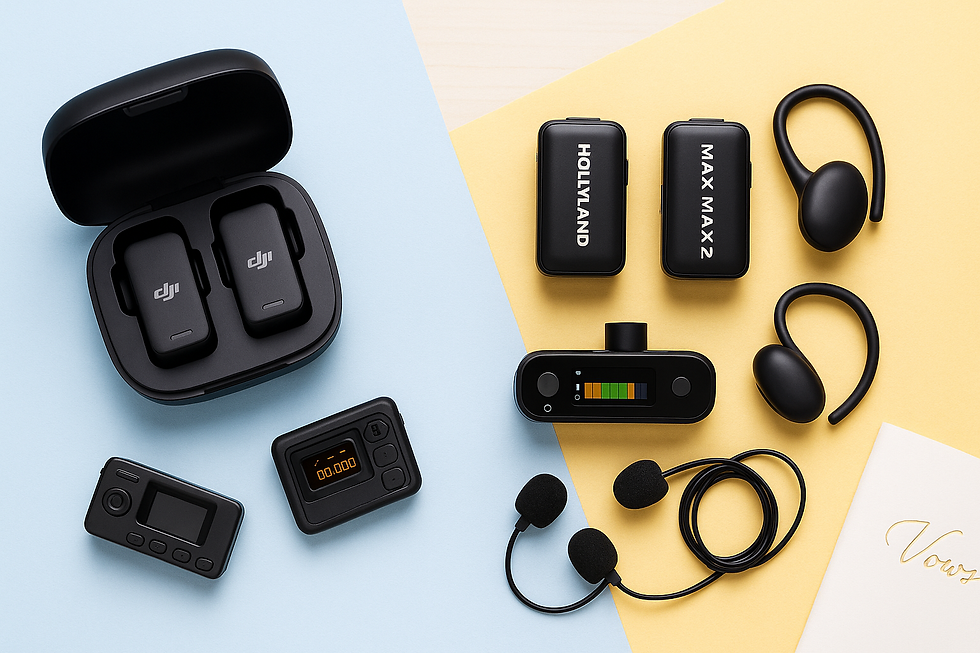DJI Osmo 360 vs Insta360 X5: 8K 360 Camera Arms Race (Should You Upgrade?)
- Webmaster
- Aug 31
- 3 min read

What “8K 360” really gives you
More detail to crop/reframe. 8K 360 (7,680×3,840) gives you far more pixels to aim a 16:9 or vertical shot after the fact, key for Shorts/Reels.
Bigger sensors = cleaner low-light. Osmo 360 lists 1/1.1-inch sensors; X5 uses dual 1/1.28-inch sensors, both a step up from many older 360 cams. Bigger photosites + better processing help with noise and dynamic range.
Specs at a glance (official)
Camera | Sensors | 360 Video (max) | Notable extras |
DJI Osmo 360 | Dual 1/1.1-in CMOS | 8K up to 30/48/50 fps; 6K up to 60; 4K 100 fps | 120MP 360 photos, D-Log M 10-bit, OsmoAudio direct mic, quick-release mount, rated 100 min at 8K/30 continuous |
Insta360 X5 | Dual 1/1.28-in sensors | 8K30 360; 5.7K60; single-lens 4K60 | PureVideo low-light mode, replaceable lenses, IP68, new AI chips, robust mobile/desktop apps |
Image quality & low-light: early takeaways
Osmo 360: Reviewers note strong low-light performance for a 360 cam, crediting the fast f/1.9 optics and large sensors. Dynamic range claims are high and footage holds detail in dim scenes.
Insta360 X5: Multiple reviews call it best-in-class overall, with PureVideo making night scenes cleaner and AI processing lifting DR.
Reframing & editing: the real creator advantage
Both ecosystems lean hard into app-first reframing:
Insta360 app/Studio: AI Edit (formerly Auto Frame) scans your clips and autogenerates reframed cuts you can tweak, fast path to vertical posts.
DJI Osmo 360: Similar mobile workflows plus flat-profile color (D-Log M) if you grade in Resolve/Premiere.
Why DJI Osmo 360 stands out
The DJI Osmo 360 pairs large 1/1.1-inch sensors with 8K capture and D-Log M for flexible grading, plus long 8K/30 recording stamina and simple mic I/O. If you’re already in the DJI ecosystem, or you value longer takes with less thermal worry, Osmo 360 is the easier drop-in upgrade.
Who should buy which?
Choose DJI Osmo 360 if you want:
The widest 8K frame-rate spread (including 48/50 fps) and long 8K/30 recording stamina.
A DJI-native workflow and direct mic connection without fiddly adapters.
Choose Insta360 X5 if you want:
The most mature reframing/editing tools on mobile/desktop with strong AI assistance.
Low-light priority with PureVideo and big sensors, plus replaceable lenses and IP68 ruggedness.
Stick with your current 360 cam if:
You mainly publish 1080p/1440p vertical, rarely crop hard, and don’t shoot at night. The jump to 8K matters most when you heavily reframe or push low-light.
Practical setup tips (creator workflow)
Shoot “oversafe.” Keep subjects ~1–2 meters from the lens to minimize stitching artifacts (any 360 cam).
Mount invisibly. Use an invisible selfie stick; avoid tripod feet in shot.
For Shorts/Reels: export vertical 1080×1920 or 1440×2560 from the app/Studio after reframing key moments.
Color: If grading DJI D-Log M, set Resolve timeline to Rec.709 and apply the DJI LUT, then tweak contrast; for Insta360, start with mild contrast/sat and protect highlights.
Recommendations
Best overall 360 for creators right now: Insta360 X5 (apps + low-light + durability). TechRadarWIRED
Best for DJI users and long 8K sessions: Osmo 360 (high 8K frame-rates, long 8K recording, D-Log M, mic I/O). DJI OfficialDJI Store
Fort Worth Creators: Our Local Tip
If you’re in Fort Worth or the DFW area, consider renting gear first or booking a studio session. At SwoleNerdProductions.com, we offer both. We’ve helped dozens of new podcasters launch right here in Texas and we’d love to help you, too.
Want a Ready-to-Go Kit?
DM us and we’ll build you a custom Amazon shopping list for your setup, based on your space, budget, and goals.









Comments